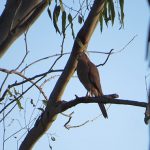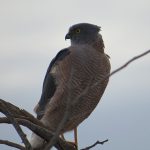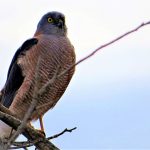COLLARED SPARROWHAWK
The Collared Sparrowhawk is a bird of prey that belongs to the Accipitridae family. It is found in various parts of Australasia, including Australia, New Guinea, and surrounding islands. The species is known for its distinctive appearance and hunting behavior.
The Collared Sparrowhawk exhibits sexual dimorphism, with females being larger than males. Adult males typically have a blue-grey upper body with a reddish-brown barred pattern on the chest and underparts. They also have a distinctive white collar on the nape of the neck, which gives the species its name. Adult females have a similar color pattern but are larger and more heavily barred.
These birds are commonly found in a variety of habitats, including woodlands, forests, urban areas, and sometimes even in gardens or suburban neighborhoods. They prefer areas with dense vegetation, as they use trees and shrubs for perching and nesting.
Collared Sparrowhawks are skilled hunters and primarily feed on small birds, such as sparrows, finches, and other small passerines. They are known for their swift and agile flight, which helps them capture prey mid-air or from perches.
Like other raptors, Collared Sparrowhawks have keen eyesight and use it to locate and pursue their prey. They are known for their secretive and stealthy behavior, often surprising their prey with sudden attacks. They may also employ a “still-hunting” technique, where they perch quietly and wait for prey to come within striking distance.
These birds build nests in trees, usually in well-concealed locations. The nests are constructed with sticks and lined with softer materials like leaves. The female typically lays around 3-4 eggs, which she incubates for several weeks until they hatch. The male assists in bringing food to the female and the chicks during the nesting period.
like many birds of prey, they face threats such as habitat loss, human disturbance, and pesticide exposure.



